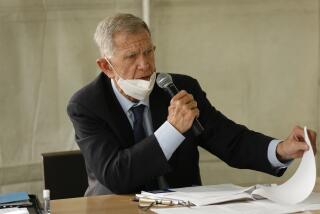Mr. Trutanich, call off the legal battle
- Share via
The protracted legal battle over whether Los Angeles city officials can seize and dispose of the unattended belongings of the homeless is not over — although it could be.
A brief history: Last year a federal court issued a temporary injunction against the seizure of property left on the sidewalks of downtown’s skid row, the most concentrated area of homelessness in Los Angeles. When the city appealed that injunction to the U.S. 9th Circuit Court of Appeals, a three-judge panel let it stand, saying the policy violates homeless people’s 4th Amendment right to be free of unreasonable seizure of their property. The city asked for a re-hearing on the matter by a larger “en banc” panel. Last week, the court rejected that request and let the injunction stand.
In other words, the city has been shot down three times. Now, City Atty. Carmen Trutanich is considering taking the issue to the U.S. Supreme Court, arguing that the 9th Circuit has stretched the definition of what is legally protected property and, consequently, made the city liable for unattended, unregistered property on public thoroughfares.
No one denies that the city has a right and a responsibility to rid its streets and sidewalks of items that endanger residents. And we understand that health and sanitation officials face a daily challenge in determining what items on a public sidewalk constitute an immediate public health hazard.
On the other hand, the homeless have a right to their possessions — and have few places to keep them but the sidewalks when they leave briefly to eat, shower or meet with a social worker. As shabby as those belongings may sometimes look, they often include important personal possessions such as identification documents, medication, family photographs, cellphones or sleeping bags.
It’s a complex problem, but city officials will not solve it by going to the Supreme Court. Instead, they should concentrate on devising plans with homeless advocates — and the lawyers who defend the homeless — to clear the streets of true safety and health hazards while coaxing people on the street to part with unsanitary items (such as dirty blankets, which could swapped for new ones) and urging them to use the free storage lockers that have been secured for this purpose. There are about 1,000 such units in the skid row area.
The city, to its credit, has already taken some steps to address the problem. This summer, after an inspection of skid row by the county Department of Public Health turned up hypodermic needles, human waste and an infestation of rats, the city launched Operation Healthy Streets, successfully sending out workers to clean the streets. Homeless people were given ample notice of the operation, and city workers helped them leave the sidewalks temporarily. They were alerted to the location of storage units and told where to reclaim any possessions they might have left behind that were not hazardous. Any other sweeps of homeless encampments around the city must now follow a protocol, set by city officials, that requires notifying the inhabitants, giving them time to leave the streets to be cleaned and offering nearby storage units, according to the city attorney’s office.
That’s all good. It suggests that the city and the homeless can work together to find a modus vivendi that will allow the streets to be cleaned while still protecting the belongings of the homeless. But ultimately, the best way to get the belongings off the streets is to get the homeless themselves off the streets. There are currently not enough beds downtown to house every homeless person in the area every night. Not that a temporary shelter is a long-term fix.
What’s needed is permanent supportive housing — which combines residential facilities with the kind of mental health and other services that will help the homeless live more stable lives — as well as more affordable housing generally. Even though the city doesn’t have the money at the moment to meet the full need, there are private organizations tackling this issue, such as Community Solutions, which worked with L.A. County officials on the successful Project 50 initiative that housed 67 formerly homeless people.
In the short term, the city must cope with the homeless and their belongings. All people, homeless or not, are protected under the U.S. Constitution from unreasonable seizure of their property, and no local ordinance can trump that protection.
It would be a waste of time and resources for Trutanich to take this case to the Supreme Court.
More to Read
A cure for the common opinion
Get thought-provoking perspectives with our weekly newsletter.
You may occasionally receive promotional content from the Los Angeles Times.






